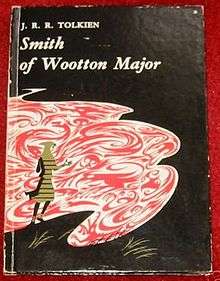Smith of Wootton Major
 First edition cover | |
| Author | J. R. R. Tolkien |
|---|---|
| Illustrator | Pauline Baynes |
| Country | United Kingdom |
| Language | English |
| Genre | Fantasy novella |
| Publisher | George Allen & Unwin |
Publication date | 9 November 1967[1] |
| Media type | Print (hardback & paperback) |
| Preceded by | The Road Goes Ever On |
| Followed by | Bilbo's Last Song (posthumous) |
Smith of Wootton Major, first published in 1967, is a novella by J. R. R. Tolkien.
Background
The book began as an attempt to explain the meaning of Faery by means of a story about a cook and his cake. This was intended to be part of a preface by Tolkien to George MacDonald's famous fairy story "The Golden Key".[2] But Tolkien's story grew to become a tale in its own right.
The most recent (2005) edition, edited by Verlyn Flieger, includes a previously unpublished essay by Tolkien, explaining the background and just why the elf-king spent so long in Wootton Major. It also explains how the story grew from this first idea into the published version.
The book was originally called The Great Cake,[2] but the title was changed to Smith of Wootton Major. The story was first published on 9 November 1967. It was first published in the United States on 23 November 1967 in the Christmas edition of Redbook magazine, but without the illustrations by Pauline Baynes that appeared in the published book.
It is not connected to the Middle-earth legendarium, except by the thematic "Faery" motif of the traveller who journeys to a land which lies beyond the normal world and is usually beyond the reach of mortals. (Smith can thus be likened to Beren in the realm of Thingol, or Eärendil journeying to Valinor, or Ælfwine's visit to Tol Eressëa.)
It is sometimes published in an omnibus edition with Farmer Giles of Ham, another Tolkien novella with illustrations by Pauline Baynes. The two stories are not obviously linked, other than by their common authorship. These two, together with The Adventures of Tom Bombadil and Leaf by Niggle, have appeared as Tales from the Perilous Realm.
Plot summary
The village of Wootton Major was well-known around the countryside for its annual festivals, which were particularly famous for their culinary delights. The biggest festival of all was the Feast of Good Children. This festival was celebrated only once every twenty-four years: twenty-four children of the village were invited to a party, and the highlight of the party was the Great Cake, a career milestone by which Master Cooks were judged. In the year the story begins, the Master Cook was Nokes, who had landed the position more or less by default; he delegated much of the creative work to his apprentice Alf. Nokes crowned his Great Cake with a little doll jokingly representing the Queen of Faery. Various trinkets were hidden in the cake for the children to find; one of these was a star the Cook discovered in the old spice box.
The star was not found at the Feast, but was swallowed by a blacksmith’s son. The boy did not feel its magical properties at once, but on the morning of his tenth birthday the star fixed itself on his forehead, and became his passport to Faery. The boy grew up to be a blacksmith like his father, but in his free time he roamed the Land of Faery. The star on his forehead protected him from many of the dangers threatening mortals in that land, and the Folk of Faery called him "Starbrow". The book describes his many travels in Faery, until at last he meets the true Queen of Faery. The identity of the King is also revealed.
The time came for another Feast of Good Children. Smith had possessed his gift for most of his life, and the time had come to pass it on to some other child. So he regretfully surrendered the star to Alf, and with it his adventures into Faery. Alf, who had become Master Cook long before, baked it into the festive cake once again for another child to find. After the feast, Alf retired and left the village; and Smith returned to his forge to teach his craft to his now-grown son.
Themes
T. A. Shippey, in The Road to Middle-earth says that "defeat hangs heavy" in the story.[3] Tolkien called it "an old man's book",[4] with presage of bereavement. Renunciation is certainly a major theme, but so is an appreciation of imaginative vision, as against the philistine outlook represented by the old cook Nokes, a shallow, sly and lazy man. Nokes is foremost among the non-believers, and dismisses all things magical as mere dreams and fancies. In the end he has a frightening encounter with the King of Faery, but even this leaves him basically unchanged in outlook.
Shippey also suggests[5] that, while Tolkien discouraged reading this story as allegory, a good case can be made that Nokes represents the literary, critical approach to studying English, belittling the contributions of the philological approach represented by the previous Master Cook. On this reading, the little star trinket added by Alf, the old Master's apprentice, turns into the talisman that cuts through Nokes's sweet, sticky nonsense and raises the smith's life from the ordinary to something deeply meaningful.
References
- ↑ Christina Scull & Wayne G. Hammond (2006), The J. R. R. Tolkien Companion and Guide, HarperCollins, 'Chronology' volume, p.711; ISBN 978-0-618-39113-4
- 1 2 H. Carpenter, J.R.R. Tolkien: a biography, "Headington", p. 244.
- ↑ T. A. Shippey, The Road to Middle-earth, "On the Cold Hill's Side", p. 277.
- ↑ Letters, no. 299, p. 389.
- ↑ T. A. Shippey, The Road to Middle-earth, "On the Cold Hill's Side", p. 272 ff.